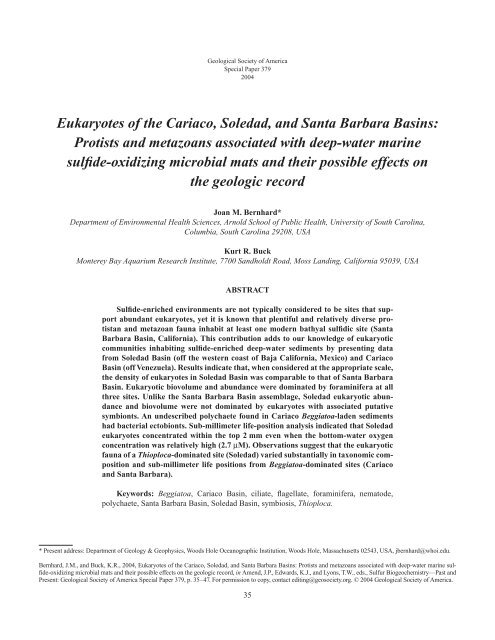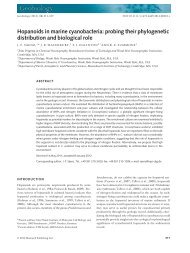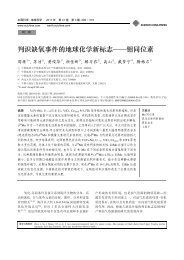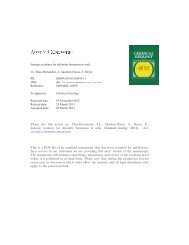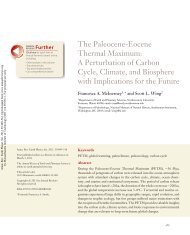Geological Society of AmericaSpecial Paper 3792004Eukaryotes of the Cariaco, Soledad, <strong>and</strong> Santa Barbara Basins:Protists <strong>and</strong> metazoans associated with deep-water marinesulfide-oxidizing microbial mats <strong>and</strong> their possible effects onthe geologic recordJoan M. Bernhard*Department of Environmental Health Sciences, Arnold School of Public Health, University of South Carolina,Columbia, South Carolina 29208, USAKurt R. BuckMonterey Bay Aquarium Research Institute, 7700 S<strong>and</strong>holdt Road, Moss L<strong>and</strong>ing, California 95039, USAABSTRACTSulfide-enriched environments are not typically considered to be sites that supportabundant eukaryotes, yet it is known that plentiful <strong>and</strong> relatively diverse protistan<strong>and</strong> metazoan fauna inhabit at least one modern bathyal sulfidic site (SantaBarbara Basin, California). This contribution adds to our knowledge of eukaryoticcommunities inhabiting sulfide-enriched deep-water sediments by presenting datafrom Soledad Basin (off the western coast of Baja California, Mexico) <strong>and</strong> CariacoBasin (off Venezuela). Results indicate that, when considered at the appropriate scale,the density of eukaryotes in Soledad Basin was comparable to that of Santa BarbaraBasin. Eukaryotic biovolume <strong>and</strong> abundance were dominated by foraminifera at allthree sites. Unlike the Santa Barbara Basin assemblage, Soledad eukaryotic abundance<strong>and</strong> biovolume were not dominated by eukaryotes with associated putativesymbionts. An undescribed polychaete found in Cariaco Beggiatoa-laden sedimentshad bacterial ectobionts. Sub-millimeter life-position analysis indicated that Soledadeukaryotes concentrated within the top 2 mm even when the bottom-water oxygenconcentration was relatively high (2.7 µM). Observations suggest that the eukaryoticfauna of a Thioploca-dominated site (Soledad) varied substantially in taxonomic composition<strong>and</strong> sub-millimeter life positions from Beggiatoa-dominated sites (Cariaco<strong>and</strong> Santa Barbara).Keywords: Beggiatoa, Cariaco Basin, ciliate, flagellate, foraminifera, nematode,polychaete, Santa Barbara Basin, Soledad Basin, symbiosis, Thioploca.* <strong>Present</strong> address: Department of Geology & Geophysics, Woods Hole Oceanographic Institution, Woods Hole, Massachusetts 02543, USA, jbernhard@whoi.edu.Bernhard, J.M., <strong>and</strong> Buck, K.R., 2004, Eukaryotes of the Cariaco, Soledad, <strong>and</strong> Santa Barbara Basins: Protists <strong>and</strong> metazoans associated with deep-water marine sulfide-oxidizingmicrobial mats <strong>and</strong> their possible effects on the geologic record, in Amend, J.P., Edwards, K.J., <strong>and</strong> Lyons, T.W., eds., <strong>Sulfur</strong> Biogeochemistry—Past <strong>and</strong><strong>Present</strong>: Geological Society of America Special Paper 379, p. 35–47. For permission to copy, contact editing@geosociety.org. © 2004 Geological Society of America.35
36 J.M. Bernhard <strong>and</strong> K.R. BuckINTRODUCTIONAlthough it has long been known that certain modern-daymarine basins such as the Black Sea are sulfide enriched, theuse of manned submersibles <strong>and</strong> remotely operated vehicles fordeep-ocean exploration has revealed that sulfidic environmentsin the modern ocean are relatively common. The discovery ofdeep-water hydrothermal vents in the 1970s prompted extensiveoceanic exploration to determine their extent. In the processof exploring these environments, extensive chemoautotrophiccommunities were discovered, the energy sources for whichare reduced compounds such as hydrogen sulfide <strong>and</strong> methane,rather than sunlight. Original biological studies concentrated onthe larger fauna <strong>and</strong> the symbiotic prokaryotes (i.e., cells lackingnuclei: bacteria <strong>and</strong> archaea) of these chemosynthetic communities.Only now are studies elucidating the smaller eukaryotic(cells with nuclei: single-celled protists <strong>and</strong> multi-celled metazoans)fauna of sulfide-enriched deep-sea habitats. This contributionpresents a synopsis of current knowledge of deep-water,sulfide-tolerant protistan <strong>and</strong> metazoan meiofauna, new ecologicaldata from selected sulfide-enriched sites, <strong>and</strong> a discourse onthe possible effects that these eukaryotes have on the geologicrecord. Because Earth’s early evolution <strong>and</strong> subsequent events ofoceanic anoxia were likely to have included sulfide enrichment(e.g., Canfield 1998), underst<strong>and</strong>ing present-day “thiobiotic”communities can help unravel past episodes in Earth’s history.Sulfide-enriched habitats in today’s oceans can occur anywherethere is organic enrichment. Besides the hard-substratehydrothermal vents <strong>and</strong> the soft-sediment associated “cold”seeps, sulfidic conditions occur in fjords, silled basins (e.g.,Santa Barbara Basin, Cariaco Basin, Black Sea), <strong>and</strong> along theopen ocean margins with well-developed oxygen minimumzones (e.g., Monterey Bay, California; off Mazatlan, Mexico). Inaddition, sulfide enrichment has been observed at large food falls,which are areas on the seafloor where the carcass of a large mammalsank to the seafloor (e.g., whale falls; Bennett et al., 1994;Deming et al., 1997).The megafaunal (e.g., bivalves, tube worms) <strong>and</strong> macrofaunal(e.g., polychaetes) chemoautotrophic communities of hydrothermalvents have been extensively studied for their physiology(e.g., Childress <strong>and</strong> Fisher, 1992), ecology (Van Dover, 2000,<strong>and</strong> references therein) <strong>and</strong> biogeography (e.g., Van Dover et al.,2002). Much information is also available regarding cold seepchemoautotrophic communities (e.g., Sibuet <strong>and</strong> Olu, 1998).Recent studies of whale-fall carcasses indicate interesting taxonomic<strong>and</strong> gene-flow patterns between these stepping stones <strong>and</strong>seeps <strong>and</strong> vents (e.g., Smith <strong>and</strong> Baco, 1998). Less is knownabout the eukaryotic fauna of silled basins <strong>and</strong> deep-water fjordsbecause many of these environments were thought to supportonly prokaryotes, given that they typically lack larger fauna.Recent studies show that high densities of protists <strong>and</strong> meiofaunalmetazoans occur in at least one bathyal oxygen-depleted, sulfide-enrichedsilled basin (Santa Barbara Basin, off California;Bernhard et al., 2000). Few studies have addressed the similarlysmall fauna of hydrothermal vents, but results suggest the presenceof ciliates (Small <strong>and</strong> Gross, 1985; Edgcomb et al., 2002)<strong>and</strong> flagellates (Edgcomb et al., 2002) at the sediment-coveredGuaymas Basin hydrothermal vent. Studies on water columnsamples collected in proximity to hydrothermal vents <strong>and</strong> theGuaymas Basin indicated flagellates capable of withst<strong>and</strong>inghigh concentrations of hydrogen sulfide (30 mM), suggestingthat these taxa may be important components of deep-waterhydrothermal vent communities (Atkins et al., 2000, 2002).Because hydrogen sulfide at micromolar concentrationsinhibits respiration, the aerobic eukaryotes of sulfide-enrichedenvironments must have physiological adaptations to allowthem to survive such conditions. The majority of physiologicalstudies on chemoautotrophic communities have been devoted tomacrofauna <strong>and</strong> megafauna; little is known about the physiologyof meiofauna (e.g., foraminifera, nematodes) <strong>and</strong> nanobiota (i.e.,ciliates, flagellates; see Gage <strong>and</strong> Tyler [1991] for more discussionon organism size classes) in any sulfide-enriched environment,<strong>and</strong> even less is known about those inhabiting deep-watersulfidic environments. In general, of the eukaryotes inhabitingsulfidic environments that have been studied, many have prokaryoticassociates (e.g., Fenchel <strong>and</strong> Finlay, 1995; Gaill 1993).For example, nematodes from shallow-water environments areknown to harbor putative symbionts (e.g., Ott et al., 1991), as dooligochaetes (Giere et al., 1991).These putative symbionts presumably provide their hostwith some metabolic byproduct(s) to promote their survival, butdemonstrating metabolic exchange between host <strong>and</strong> prokaryoteis difficult, especially in small eukaryotes such as nanobiota <strong>and</strong>meiofauna. Prokaryotic associates can be endobionts (livinginside the host) or ectobionts (living on the host). In some cases,both endobionts <strong>and</strong> ectobionts occur (e.g., species of the ciliateMetopus; Esteban et al., 1995). Symbionts of metazoan (aerobic)hosts are typically sulfide oxidizers (e.g., nematodes, Polz et al.,1994; Hentschel et al., 1999) or methanotrophs (e.g., bivalves;Vetter <strong>and</strong> Fry, 1998). In some vent mollusks, both of thesetypes of endosymbionts can be present (e.g., Cavanaugh et al.,1992). In addition, an oligochaete species is known to harbor twotypes of endosymbionts: sulfate-reducers <strong>and</strong> sulfide-oxidizers(Dubilier et al., 2001). Symbionts of anaerobic flagellate hostsare known to be methanogens (e.g., Fenchel <strong>and</strong> Finlay, 1992)or sulfate reducers (Fenchel <strong>and</strong> Ramsing, 1992).A number of eukaryotes inhabiting sulfide-enriched habitatslack symbionts; their adaptations to sulfide exposure are varied.For example, in some animals, sulfide oxidation occurs in mitochondria.The hemoglobin of some metazoans binds sulfide toprevent or minimize its detrimental effects on respiration. Whenrespiration is inhibited, a sulfur-dependent anaerobic energymetabolism can be invoked. For details regarding these adaptations,the reader is directed to reviews by Somero et al. (1989),Vismann (1991), Childress (1995), Grieshaber <strong>and</strong> Völkel(1998), <strong>and</strong> Hagerman (1998).From the geological perspective, laminated sediments areinvaluable to studies of climate change on annual, decadal, <strong>and</strong>
- Page 2: Sulfur Biogeochemistry—Past and P
- Page 8: Preface viisulfurization on the pre
- Page 11 and 12: 2 V. BrüchertThe resulting sulfur
- Page 13 and 14: 4 V. BrüchertFigure 1. Phylogeneti
- Page 15 and 16: 6 V. Brüchertnot yet been resolved
- Page 17 and 18: 8 V. BrüchertEFFECT OF ELECTRON DO
- Page 19 and 20: 10 V. Brüchertfractionation factor
- Page 21 and 22: 12 V. BrüchertFigure 4. Depth prof
- Page 23 and 24: 14 V. Brüchertto derive isotope fr
- Page 25 and 26: 16 V. BrüchertRudnicki, M.D., Elde
- Page 28 and 29: Microbially mediated sulfur-redox 1
- Page 30 and 31: Microbially mediated sulfur-redox 2
- Page 32 and 33: Microbially mediated sulfur-redox 2
- Page 34 and 35: Microbially mediated sulfur-redox 2
- Page 36 and 37: Microbially mediated sulfur-redox 2
- Page 38 and 39: Microbially mediated sulfur-redox 2
- Page 40 and 41: Microbially mediated sulfur-redox 3
- Page 42 and 43: Microbially mediated sulfur-redox 3
- Page 46 and 47: Eukaryotes of the Cariaco, Soledad,
- Page 48 and 49: Eukaryotes of the Cariaco, Soledad,
- Page 50 and 51: Eukaryotes of the Cariaco, Soledad,
- Page 52 and 53: Eukaryotes of the Cariaco, Soledad,
- Page 54 and 55: Eukaryotes of the Cariaco, Soledad,
- Page 56: Eukaryotes of the Cariaco, Soledad,
- Page 59 and 60: 50 A. SchippersTABLE 1. DETECTION O
- Page 61 and 62: 52 A. SchippersS 4O 62−+ H 2O →
- Page 63 and 64: 54 A. Schippersthe oxygen molecule
- Page 65 and 66: 56 A. Schippersprohibits biological
- Page 67 and 68: 58 A. SchippersSampleTABLE 4. SULFU
- Page 69 and 70: 60 A. SchippersGeochimica et Cosmoc
- Page 71 and 72: 62 A. SchippersSasaki, K., Tsunekaw
- Page 73 and 74: 64 B.B. Jørgensen and D.C. NelsonI
- Page 75 and 76: 66 B.B. Jørgensen and D.C. NelsonF
- Page 77 and 78: 68 B.B. Jørgensen and D.C. Nelsonq
- Page 79 and 80: 70 B.B. Jørgensen and D.C. Nelsons
- Page 81 and 82: 72 B.B. Jørgensen and D.C. Nelsonp
- Page 83 and 84: 74 B.B. Jørgensen and D.C. NelsonP
- Page 85 and 86: 76 B.B. Jørgensen and D.C. Nelsont
- Page 87 and 88: 78 B.B. Jørgensen and D.C. NelsonF
- Page 89 and 90: 80 B.B. Jørgensen and D.C. NelsonJ
- Page 92 and 93: Geological Society of AmericaSpecia
- Page 94 and 95:
Formation and degradation of seafl
- Page 96 and 97:
Formation and degradation of seafl
- Page 98 and 99:
Formation and degradation of seafl
- Page 100 and 101:
Formation and degradation of seafl
- Page 102 and 103:
Formation and degradation of seafl
- Page 104 and 105:
Formation and degradation of seafl
- Page 106 and 107:
Geological Society of AmericaSpecia
- Page 108 and 109:
Distribution and fate of sulfur int
- Page 110 and 111:
Distribution and fate of sulfur int
- Page 112 and 113:
Distribution and fate of sulfur int
- Page 114 and 115:
Distribution and fate of sulfur int
- Page 116 and 117:
Distribution and fate of sulfur int
- Page 118 and 119:
Distribution and fate of sulfur int
- Page 120 and 121:
Distribution and fate of sulfur int
- Page 122 and 123:
Distribution and fate of sulfur int
- Page 124 and 125:
Distribution and fate of sulfur int
- Page 126 and 127:
Geological Society of AmericaSpecia
- Page 128 and 129:
- HSO 4SO 2-4H 2 SCO 32-HCO 3-HCO 3
- Page 130 and 131:
Sedimentary pyrite formation 121mar
- Page 132 and 133:
Sedimentary pyrite formation 123The
- Page 134 and 135:
Sedimentary pyrite formation 125Ben
- Page 136 and 137:
Sedimentary pyrite formation 127TAB
- Page 138 and 139:
Sedimentary pyrite formation 129The
- Page 140 and 141:
Sedimentary pyrite formation 131Dek
- Page 142 and 143:
Sedimentary pyrite formation 133Mor
- Page 144 and 145:
Geological Society of AmericaSpecia
- Page 146 and 147:
Recent advances and future research
- Page 148 and 149:
Recent advances and future research
- Page 150 and 151:
Recent advances and future research
- Page 152 and 153:
Recent advances and future research
- Page 154 and 155:
Recent advances and future research
- Page 156 and 157:
Recent advances and future research
- Page 158 and 159:
Recent advances and future research
- Page 160 and 161:
Geological Society of AmericaSpecia
- Page 162 and 163:
Using sulfur isotopes to elucidate
- Page 164 and 165:
Using sulfur isotopes to elucidate
- Page 166 and 167:
Using sulfur isotopes to elucidate
- Page 168 and 169:
Using sulfur isotopes to elucidate
- Page 170 and 171:
Geological Society of AmericaSpecia
- Page 172 and 173:
Sites of anomalous organic reminera
- Page 174 and 175:
Sites of anomalous organic reminera
- Page 176 and 177:
Sites of anomalous organic reminera
- Page 178 and 179:
Sites of anomalous organic reminera
- Page 180 and 181:
Sites of anomalous organic reminera
- Page 182 and 183:
Sites of anomalous organic reminera
- Page 184 and 185:
Sites of anomalous organic reminera
- Page 186 and 187:
Geological Society of AmericaSpecia
- Page 188 and 189:
Sulfur isotope composition of carbo
- Page 190 and 191:
Sulfur isotope composition of carbo
- Page 192 and 193:
Sulfur isotope composition of carbo
- Page 194 and 195:
Sulfur isotope composition of carbo
- Page 196 and 197:
Sulfur isotope composition of carbo
- Page 198 and 199:
Sulfur isotope composition of carbo
- Page 200 and 201:
Sulfur isotope composition of carbo
- Page 202 and 203:
Sulfur isotope composition of carbo
- Page 204 and 205:
Geological Society of AmericaSpecia
- Page 206 and 207:
4 Ga of seawater evolution 197brine
- Page 208 and 209:
4 Ga of seawater evolution 199Figur
- Page 210 and 211:
4 Ga of seawater evolution 201data
- Page 212 and 213:
4 Ga of seawater evolution 203notab
- Page 214:
4 Ga of seawater evolution 205et Co


